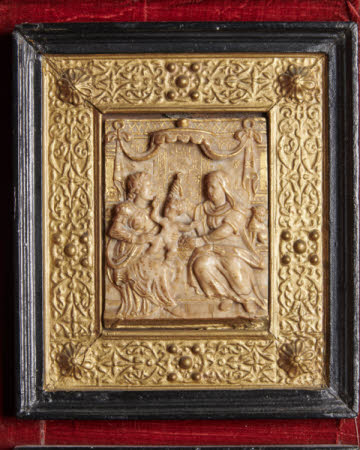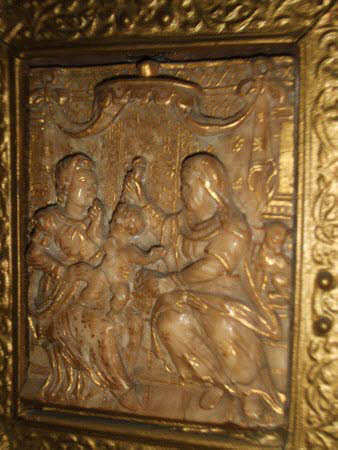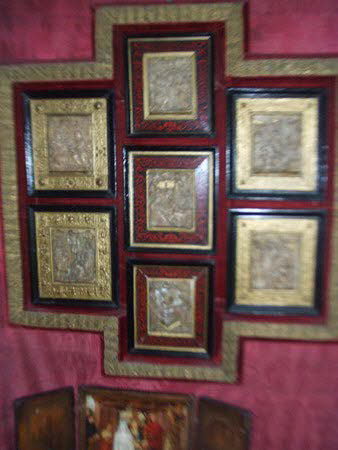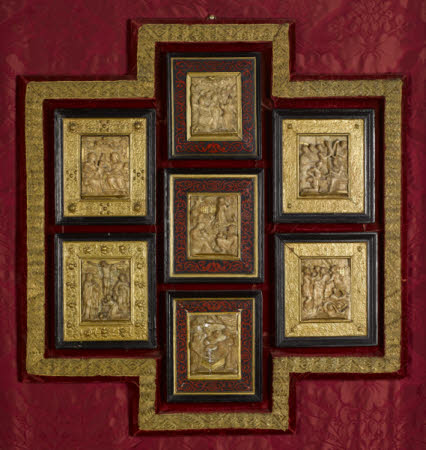The Holy Family with Saint Anne and a lamb, from a series of reliefs with stories from the Life and Passion of Jesus Christ
Malines (Mechelen) Alabaster School (fl.16th-17th century)
Category
Art / Sculpture
Date
circa 1600
Materials
Alabaster
Measurements
225 x 200 mm
Place of origin
Malines (Mechelen)
Order this imageCollection
Mount Stewart, County Down
NT 1655922.3
Summary
Sculpture, alabaster; the Virgin Mary with the baby Jesus Christ and Saint Anne, within an interior; Mecheln (Malines); c. 1600. A small alabaster relief from a group of seven (NT 1655922) depicting scenes from the life and Passion of Jesus Christ, made in the southern Netherlands. This is a more general devotional scene, showing the Virgin Mary and her mother Saint Anne within a rich interior, sitting in a homely fahion upon a bed, between them the lively Christ Child. The seven reliefs were kept with other small religious scuptures in the bedroom of Edith, Marchioness of Londonderry.
Full description
A small alabaster panel depicting the Holy Family, with the Virgin Mary and the baby Jesus Christ and Mary’s mother, Saint Anne. The scene is set within an opulent interior, with Mary and Anne sitting upon the end of a bed, which has at its head a bell-shaped canopy and rich hangings. Mary at left holds the Christ Child who excitedly reaches out to touch his mother’s chin, whilst reaching across to his grandmother, seated at right, and who holds an object, perhaps a toy of some sort, in her right hand. A lamb is seated at far right. Stepped ledge at bottom. Some restoration to the gilding. Mounted in its original frame, black-painted, with an inner frieze of stamped and gilded gesso work with arabesque decoration and floral bosses. The theme of the Holy Family with Saint Anne, depicting three generations, grandmother, mother and child, was especially popular in Northern Europe in the fifteenth and sixteenth centuries. The presence of the lamb refers to Christ’s precursor and prophet Saint John the Baptist, who is often seen in depictions of the Holy Family, as a small child with Christ. The relief is one of a group of seven reliefs at Mount Stewart, probably acquired by Edith, 7th Marchioness of Londonderry and displayed in her bedroom, ‘Genoa’, arranged upon a velvet panel in the form of a cross. The 1950 inventory of Mount Stewart records just six reliefs, so it is possible that the seventh was acquired some time in the 1950s. The alabaster reliefs are part of a small collection of devotional objects kept in a corner of Genoa. In their arrangement by Lady Londonderry, the alabaster panels do not follow any liturgical order, but they all illustrate scenes from the Life and Passion of Christ: The Holy Family, with Saint Anne (NT 1655922.3) Agony in the Garden (NT 1666922.5) Betrayal of Christ (NT 1655922.4) Crowning with Thorns (NT 1655922.2) Crucifixion (NT 1655922.7) Entombment (NT 1655922.6) Pentecost (NT 1655922.1) The Mount Stewart reliefs are products of a prolific industry in alabaster carving in the southern Netherlands, that had its main centre in the city of Mechelen (Malines), and was active from c. 1550-1630. Alabaster is a form of gypsum. It has long been popular as a material for sculpture, for its relative softness and ease of carving, its attractive translucency and whiteness and its cheapness compared to marble. In England, from the twelfth through to the sixteenth centuries, alabaster carvings were produced in vast numbers by workshops based mainly in the English Midlands. The most common products of the English workshops were figurative panels, usually religious in subject matter, which formed the basis of large multi-panel altarpieces or else were used in smaller single-panel devotional altars. English alabasters were exported widely throughout Europe before the Protestant Reformation, which in England brought a sudden end to this trade. The gap in the market this created from around 1540 was quickly compensated for by the development of an important school of alabaster sculpture in the Southern Netherlands, especially in the towns of Mechelen (Malines) and Antwerp. The Mechelen alabaster workshops, which operated from around 1550 to 1630, became much more important later in the sixteenth century, as Antwerp went through severe economic crises. As well as altarpieces, these workshops specialised in making large numbers of small reliefs, often in series and generally smaller than the English alabasters, but replicating many of their subjects, albeit in a more modern late Renaissance style. The reliefs were made in enormous numbers by the artisans, who were known as ‘cleynstekers’ (carvers of small works) or ‘albastwerkers’ (alabaster workers). Sometimes the small panels were incorporated into larger altarpieces, such as the Entombment, set into the upper section of an altarpiece from c. 1550-60 in the Victoria & Albert Museum (Inv. 587-1883; Williamson 2002, pp. 150-51, cat. 50). But they were much more commonly individually framed, with the the frames incorporating decorative friezes stamped and gilded gesso. The reliefs themselves were invariably also partly gilded, so when they were freshly made they must have been spectacular in appearance, even though they were rather mass-made products, mostly modest in quality. Prints must have provided the sources for many of the images, although there is also some evidence that designs were produced in some of the Mechelen workshops. The seven Mechelen reliefs at Mount Stewart have been gathered from different sources and are certainly the products of more than one workshop. Mechelen alabasters quite often bear workshop marks which have allowed a number of these reliefs to be identified as the products of named workshops. No marks are however visible on any of the Mount Stewart reliefs. In terms of its concept and the quality of its carving, the Holy Family is the best of the seven Mechelen reliefs at Mount Stewart. No print source for the composition has yet been identified, although it is quite close in conception to an engraving made by Jan Sadeler I (1550-1600) after a design by Maerten de Vos, published in 1584. The design is quite innovative, with the grand and rich bed depicted straight on to the viewer, and the protagonists seated upon it in an informal and naturalistic manner. No comparable Mechelen reliefs of this subject are currently known, although rather similar grand interiors with a baldacchino are used for the scenes of the Last Supper (Bès de Bec 2003, pp. 128-30). Jeremy Warren August 2022
Provenance
Probably acquired by Edith, Marchioness of Londonderry (1878-1959); by descent to Lady Mairi Bury (1921-2009); accepted by HM Government in lieu of Inheritance Tax and allocated to the National Trust, 2013.
Makers and roles
Malines (Mechelen) Alabaster School (fl.16th-17th century), sculptor
References
Mount Stewart 1950: Inventory and Valuation of the Contents of Mount Stewart, Newtownards, County Down, the property of the Marchioness Dowager of Londonderry, D.B.E. Prepared for the purpose of insurance by H. Clifford-Smith, M.A. F.S.A. 1950, p. 43. Jansen 1964: Ad Jansen, ‘Mechelse Albasten‘, Handelingen van de Koninklijke Kring voor Oudheidkunde, Letteren en Kunst van Mechelen, 68 (1964), pp. 111-191. Derveaux-van Ussel 1967: Ghislaine Derveaux-van Ussel, ed., Mechelner Alabaster, exh. cat., Städtsiches Museum, Trier 1967 Derveaux-van Ussel 1967a: Ghislaine Derveaux-van Ussel, Exposition de Sculptures anglaises et malinoises d’Albâtre, exh. cat., Musées Royaux des Beaux-Arts, Brussels 1967. Williamson 2002 : Paul Williamson, Netherlandish Sculpture 1450-1550. London 2002 Bès de Berc 2003: Guy Bès de Berc, Sculptures d’albâtre de Malines. Les reliefs de dévotion, fin XVIème début XVIIème siècle, Saint Armel 2003. Lipinska 2015 : Aleksandra Lipińska, Moving Sculptures. Southern Netherlandish Alabasters from the 16th to 17th centuries in Central and Northern Europe, Leiden 2015.




